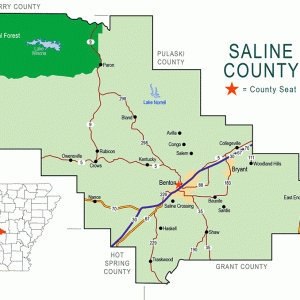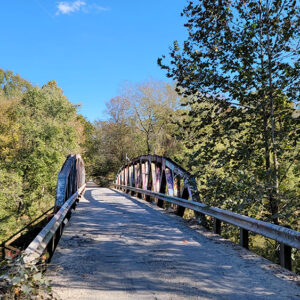calsfoundation@cals.org
Shaw (Saline County)
Located six miles south of present-day Benton (Saline County) on Highway 35, the unincorporated community of Shaw is one of Saline County’s oldest settlements. Shaw’s northern boundary follows Highway 35 to Peacock Hill. Its eastern boundary takes in the original post office, named for French explorer Henri de Tonti. Its western boundary is a heavily wooded area adjoining the town of Haskell (Saline County). To the south, Shaw’s borders include some of northern Grant County.
The founder of the community, Hiram M. Shaw, was born on December 24, 1805, in what was then Walker County, Georgia. In 1857, he and his wife, Elizabeth Arnold Shaw, moved their family to Arkansas, becoming some of the first white settlers in what is now Shaw. Shaw opened the first post office in the area, which he named Merritt, and served as its postmaster from 1872 to 1874. When he died on November 9, 1874, Shaw owned 160 acres of land with sixty acres set aside for cultivation. Hiram Shaw’s father and mother, Haley G. Shaw (a Revolutionary War veteran) and Rebecca Hodges Shaw, are buried at New Friendship Cemetery in Shaw alongside their son. Three of Hiram and Elizabeth Shaw’s sons fought on the Confederate side during the Civil War; all three died during the war.
Another early settler was David S. Ramsey of Hall County, Georgia, who moved his family into the area in the fall of 1854. Ramsey purchased 160 acres and used his skills as a hunter to make a living selling furs and hides. Ramsey was also one of three men in Saline County at the time who owned and operated a distillery. In the Civil War, Ramsey was a scout under General James Fagan until the war ended in 1865. Ultimately, he came to own 640 acres, which was divided amongst his children when he died.
New Friendship Missionary Baptist Church was organized sometime before 1869. Pleasant Hill Methodist Church in Shaw was reportedly built in 1870. New Friendship doubled as Shaw’s first school in the mid-1800s. The Saline Township School District was organized on October 13, 1873. Shaw’s first official schools would come soon afterward. It was not until 1876 that Shaw Township was cut from the larger and much older Saline Township, which was created in 1836.
The first post office bearing the Shaw name was established on November 2, 1881, with James P. Smith serving as its postmaster. By 1884, Shaw Township’s population was just 100. As late as 1898, residents of Shaw Township had to go to nearby Benton to access the nearest bank. On March 10, 1899, the Saline Courier, then called the Saline County Times Courier, listed Shaw among its established mail routes out of Benton. The Detonti (Saline County) post office was established two miles from the center of Shaw Township in 1906 in the Young-Carson general store. James (Jim) Carson was its first postmaster. The older Shaw post office closed in 1914, leaving all mail to go through the newer Detonti office until it closed in March 1955. After that, all mail coming and going from Shaw, Tull (Grant County), and northern Grant County went through Benton.
Shaw’s first grand lodge (Freemasons) was chartered on January 7, 1873. Industry came to Shaw Township during the Reconstruction period immediately following the Civil War. The Iron Mountain Railroad was built through Saline County in 1873. Soon afterward, grist mills and cotton gins were built in the area. Also in the 1800s, the St. Louis and Southern Railroad was built through the area, beginning an economic boom to the state. Lumber became Shaw Township’s largest industry by the 1880s. Shaw’s forests provided ample amounts of virgin pine, oak, and hickory; Shaw also had many sawmills. Paul W. Rucker moved to Shaw in 1880, and by 1883, he and David S. Ramsey opened the town’s earliest milling and ginning enterprise, soon to be joined by Cicero Holt Rucker, Paul’s brother. The Arkansas Gazette noted in the late 1880s that Paul Rucker’s operation was the best gin and grist mill in operation at that time.
M. A. Reynolds had oil and natural gas leases in Shaw in 1919. The Arkansas Short Leaf Lumber Company built an oil well 100 yards west of the Shaw-Tull road. Their derrick was 112 feet high and hit rock after digging just twenty feet in 1906. By January 10, 1924, a reported $100,000 had been invested in the operation, and 100 quarts of nitro-glycerin were used but to no avail. On January 12, work was suspended. Also in 1924, the Superior Bauxite Company opened a mine in Shaw near Mt. Olive Church. The first bauxite mine in Shaw had been opened in 1914 by the Globe Bauxite Company. The Crouch Mining Company also opened during World War I when William J. Crouch leased forty acres near the Detonti post office.
The Shaw School reached its peak enrollment in the 1930s; in 1949, it was consolidated with nearby Bauxite School District. The Shaw Home Demonstration Club, created in the 1930s, was sponsored by the Federal Emergency Relief Administration. The club educated locals on the benefits of canning to preserve fruits, vegetables, and meats. By 1935, the club provided canning services for local farmers. Farmers had to agree to give one out of every seven cans of fruits and vegetables, and one out of every ten cans of meat, to the club supervisor. This allowed the club to build a food pantry for emergency relief.
In September 1938, the Arkansas Department of Public Utilities had Saline County’s first electric lines built by the Rural Electric Administration, bringing electricity to the area for the first time. It took at least ten years to complete. Leona Rucker, who later created the Alcoa newsletter Pick and Shovel, lived in Shaw with her husband, Sam. Rucker is recognized for being Saline County’s first female sheriff. Her brother Virgil Rucker also served as sheriff.
The Shaw community was eventually dwarfed in terms of population by nearby Benton and Haskell. One of its most well-known landmarks, Shaw Bridge, which crosses the Saline River, first connected Haskell and Shaw in the late 1920s. It was 388 feet long and was one lane wide. Like the Old River Bridge at Benton and the Tull Bridge nearby, the Shaw Bridge sported a wooden platform supported by steel trusses. The original Shaw Bridge was replaced in 1997 by a shorter (230 foot) arched through-truss bridge with steel rails on each side.
For additional information:
Biographical and Historical Memoirs of Pulaski, Jefferson, Lonoke, Faulkner, Grant, Saline, Perry, Garland, and Hot Springs Counties in Arkansas. Chicago: Goodspeed Publishing Co. 1890.
Coppock, Shirley Parson. Some History about Shaw Township Saline County, Arkansas. Little Rock: A&I Studio Press, 2005.
Fulcher, Melton. “Shaw Community.” In Saline County Recollections of Early Settlers. 2nd ed. Benton, AR: Saline County History & Heritage Society.
Cody Lynn Berry
University of Arkansas at Little Rock
 Saline County Map
Saline County Map  Shaw Bridge
Shaw Bridge  Shaw Bridge
Shaw Bridge  Shaw Bridge
Shaw Bridge 




Comments
No comments on this entry yet.